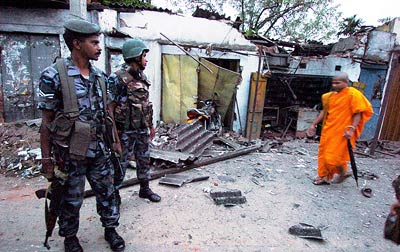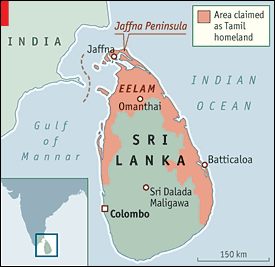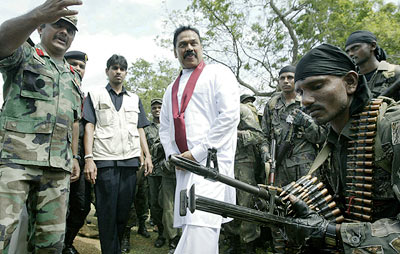Ilankai Tamil Sangam30th Year on the Web Association of Tamils of Sri Lanka in the USA |
|||
 Home Home Archives Archives |
A War Stranger Than Fictionby The Economist, June 7, 2007
More typically, however, the refugees—of whom there are over 100,000 near Batticaloa—describe a less savage sort of warfare. They heard artillery shells exploding near their villages, and they ran. Sometimes the army, which, like the government, is almost entirely composed of Buddhist Sinhalese, a bullying majority, told them the bombardment was coming. At any rate, in nine months of almost constant artillery barrage, mostly by the army, which has depopulated much of Sri Lanka's formerly Tiger-held east, the shelling has killed only around 100 civilians. As the refugees speak, crowding together on the blistering sand or under wilting plastic sheeting, a periodic ground-muffled boom resounds. From the roads and villages that it controls, every few minutes, the government is shelling the green jungle beyond. The Conradian imagery is appropriate. There is something strange about Sri Lanka's 24-year ethnic war, a mismatch of high and low intensity, of first world and third, that almost savours of fiction. Horrors like that visited upon Radikhela and her family should not be happening in Sri Lanka. With an income per head of $1,350, almost twice India's, it is a bright star of South Asian development. Its economy grew by an average of 5% during the 1990s, even as the war raged. It grew by around 7% last year, when the war was re-ignited after an unprecedented three-year pause. And this growth also came despite the devastating tsunami of December 2004, in which 35,000 Sri Lankans died. What is more, Sri Lanka is an unusually delightful war-torn country. Half a million tourists last year are a sign of that. It has well-watered hills, rolling green tea estates and miles of palm-fringed white sands. Sri Lanka's almost wholly literate inhabitants, 75% of them Sinhalese and 12% Sri Lankan Tamils, share an understandable pride in their island. Away from the war zone—despite a history of pogroms and other discrimination against the minority group—they seem to rub along reasonably well. Meanwhile an ugly war that has claimed over 70,000 lives flickers and, as currently, flares. Last year, according to official figures, more people died violently in Sri Lanka than in Afghanistan. In the past 18 months over 5,000 have been killed, compared with fewer than 200 in the previous three years. Sri Lankan pundits are calling this violence “Eelam War IV”: the fourth round in the struggle for an Eelam, or independent Tamil homeland. A ceasefire, brokered by Norway in 2002, is officially still in place. Yet government and Tigers are both preparing for bigger battles. A peaceful resolution to Sri Lanka's conflict may never have looked less possible. As the shells rained around Batticaloa on June 2nd, the Tigers launched a fierce night attack along the front line near Omanthai, south of their northern fief. The Tigers say they killed 30 soldiers. The army says it killed 52 Tigers, including many of the child fighters that their leader, a tyrannical hermit called Velupillai Prabhakaran, prefers. Both sides are prone to lie. But on June 5th the Tigers handed over 13 army corpses to the Red Cross. Strategies of terror Yet many, perhaps most, of the war's victims did not fall in pitched battle. Guerrilla and terrorist attacks by the Tigers have cost hundreds of soldier and civilian lives. On May 28th seven soldiers and civilians were killed, and dozens wounded, by a Tiger roadside bomb in Colombo. On May 24th the Tigers claimed to have killed 32 sailors in an attack by their naval wing, the Sea Tigers, on an island off the isolated government-held Jaffna peninsula. The government of President Maninda Rajapakse also uses terrorism. More than 300 Tamil civilians, including many with family links to the Tigers, have been murdered in Jaffna alone. Armed members of a Tamil political party, the Eelam People's Democratic Party (EPDP), allegedly with close ties to army spies, have been accused of some of these killings. After the Tiger attack near Omanthai, on June 5th, the army chief, Lieut-General Sarath Fonseka, said it was time for a new ceasefire. If he meant it, this would be a big strategic shift by the government. Earlier this year, after a visit to Sri Lanka's holiest Buddhist site, Sri Dalada Maligawa, General Fonseka promised to “annihilate” the Tigers. Alas, there are reasons to doubt the general's change of heart. His comment this week looked suspiciously well-timed to coincide with a visit from Yasushi Akashi, a so-called “peace envoy” from Japan, Sri Lanka's biggest aid donor. Moreover, when the government has experienced setbacks, it tends to tone down its pugnacity. It did so after a disastrous attack launched from Jaffna last October, in which independent reports suggest that around 200 soldiers were killed and six tanks (nearly half of the army's total) were captured, with not a yard gained. In an interview last week, General Fonseka seemed uncertain what strategy the government was pursuing. Asked if he would continue attacking the Tigers in the north, he said: “We don't have anything on the drawing-board...there will be a political solution, there will be peace talks.” Yet at the same time, “A political solution can never come while the LTTE is strong.” In the east the army now holds more ground than it has for a decade. With 25,000 soldiers around Batticaloa, it is trying to drive an estimated 500 Tigers from their last two eastern hideouts, in thick jungle to the north-west and south-west of the town. General Fonseka says this will be done within two weeks. Yet whether the army can retain its ground as the refugees return, with Tigers hiding among them, is uncertain. Either way, it would be wrong to call this campaign a military triumph. It owes more to the defection in 2004 of the Tigers' eastern commander, Vinayagamoorthy Muralitharan, who is known as Colonel Karuna. Compliant in the way of other militias, Colonel Karuna demobilised 5,000-6,000 Tiger fighters ahead of the army's advance. He has since recruited a fresh militia, including, says the UN, over 200 children. This mob, which itself split last month, is being used by the government in time-honoured fashion: for intelligence, to rile the Tigers and to murder its opponents. The government, of course, denies this. The north is a different case. As Colonel Karuna's defection suggests, the Tigers' grip on the east was always loose. The eastern population includes many Muslims and Sinhalese, and eastern Tamils consider themselves different from—and speak a different dialect to—the Jaffna Tamils who dominate the Tigers. In the north, however, Mr Prabhakaran runs a de facto state, with its own police force, justice system and tax regime. Penetrating the minefields and fortified trenches that encircle it, as the army has several times tried, would be bloody and perhaps impossible. Indeed, the Tigers' attack near Omanthai was retaliation for the army's latest half-dozen failed attempts. The government denies it; but a joint Norwegian-Icelandic monitoring mission says that around 200 soldiers were involved in each of these attacks, which were also near Omanthai. Up to a third of them were killed. Ships and boats and planes This is another oddity of Sri Lanka's war: the many-times proven ability of 10,000 self-trained guerrillas to defeat the government's 250,000 armed forces in conventional battles. A shimmering example of this is the Tigers' latest weapons system: a fleet of ten light aircraft, imported in pieces during the ceasefire and unveiled in two recent bombing raids on Colombo. One night in April, as the capital's air defences blazed wildly into the night sky, the flying Tigers dropped bombs on a gas installation and an air force base. The Czech-made planes are believed to have a top speed of 260kph. To shoot them down, the government is negotiating to buy five Russian MIG-29s, capable of a speed of 2,400kph. A top official suggested it would do better to buy a couple of second-world-war British Spitfires. A main reason for the Tigers' success is their support base: a loyal and prosperous Tamil diaspora in America, Canada, Britain and Australia. Around 700,000 refugees from the current conflict are among them. The Tigers tax these exiles. Involvement in criminal schemes, notably credit-card fraud, also provides cash to buy arms. To bring in the guns, bought from South-East Asian arms dealers, the group has a merchant fleet of ten ocean-going vessels. In recent months the government claims to have sunk three of these ships, laden with guns bought in Indonesia. It seems, however, that these were different vessels, chartered for the task. Whatever General Fonseka is planning, a military end to the war looks impossible. A pity, then, that Mr Rajapakse looks so incapable of peacemaking. He won election in November 2005 in part by promising the Sinhalese masses a less conciliatory approach to the Tigers than that shown by his opponent, Ranil Wickremesinghe, a former prime minister. By agreeing to a ceasefire, which recognised the Tigers' control of the north, Mr Wickremesinghe had riled many Sinhalese nationalists. Those nationalists—led by a bigoted Buddhist clergy, whose small but shrill political party shares power with Mr Rajapakse's Sri Lanka Freedom Party—considered the ceasefire a precursor to splitting the country. Since in their view the Sinhalese are the sole owners of Sri Lanka, and all minorities are alien to it, this was unacceptable. Though the monks' orange-robed parliamentary leader, the Venerable Athuraliye Rathana, wants peace for most sentient beings, Tamil rebels are clearly excluded. “Day by day we are weakening them with our military force,” he says. “Talk can come later.” The second secret to Mr Rajapakse's election was that, at the Tigers' command, north-eastern Tamils did not vote. Had they done so, most would have plumped for Mr Wickremesinghe, whose peacemaking delivered freedoms to travel and trade that they had not enjoyed in decades. This had represented a challenge to Mr Prabhakaran. Autocratic to his fingertips, incapable of sharing power even with trusted deputies such as Colonel Karuna, he wanted out of the peace process. Mr Prabhakaran declared the election a Sinhalese affair, not for independence-seeking Tamils. A Sinhalese-chauvinist government suits Mr Prabhakaran, helping bolster Tamil support for the Tigers. Recent reports have even suggested that he struck a secret deal with the opportunistic Mr Rajapakse. In return for, in effect, delivering Mr Rajapakse to power, Mr Prabhakaran was promised cash, Colonel Karuna in chains and recognition of the Tigers' control of the east. Yet no sooner was Mr Rajapakse elected than both sides were shelling and murdering each other. Within six months, the war was back on. Or rather, it had reverted to a different phase of what many Sri Lankans see as an endless cycle. On the government side, Mr Rajapakse's pledge to get tough on the Tigers has been heard from previous Sinhalese populists. Among southern Sinhalese this message is effective. In their pretty fishing villages and state-subsidised paddy-fields, most are too removed from the war to feel much urgency to end it. According to a poll in February by the Centre for Policy Alternatives, a Sri Lankan think-tank, 59% of Sinhalese wanted a “military solution” to the conflict. Mr Wickremesinghe's predecessor, President Chandrika Kumaratunga, had also tried to please this majority. She waged a policy of “war for peace” against the Tigers—as unsuccessful as it was illogical. But Mr Rajapakse has plunged further into the past. Though the Tigers demand independence for the north-east, most Tamils would settle for a decent measure of autonomy. At the last round of peace talks, in Oslo in 2004, even the Tigers seemed to accept this; they issued a demand for “internal self-determination”. Mr Rajapakse, however, has proposed as his solution a modest devolution at the village level. This idea, modelled on India's system of Panchayats, was aired, and discredited, in the early 1980s. What Tamils want It is hard to exaggerate how inadequate, and depressing, most Tamils considered this. Yet Mr Rajapakse perhaps need not care. He remains popular, and not only for waging war. Mr Wickremesinghe made himself unpopular by introducing liberal economic reforms. By cutting a ruinous subsidy on paddy fertiliser, for example, he lost the votes of many peasant farmers. Among other populist measures, Mr Rajapakse has restored the subsidy. He has also tightened his grip in even less admirable ways. Wary of political allies, Mr Rajapakse has appointed his three brothers to run important ministries. He has nabbed the ministries of finance, defence and public works for himself. Together, the brothers Rajapakse control over 70% of Sri Lanka's budget. The defence budget, which was increased by 40% this year, is being overseen by the unelected Gotabhaya Rajapakse. A former fire-eating army officer who spent 17 years in America, at one time managing a 7-Eleven store, Mr Rajapakse has proved as bellicose as Mr Prabhakaran and General Fonseka combined. The government's profligacy and misrule is taking a toll. To sustain public expenditure, the governor of the central bank, another crony of Mr Rajapakse, has printed lots of new money. This has helped drive inflation to around 15%. Collapsing tourist revenues after the Tigers' blitz on Colombo augur more economic damage. Yet Mr Rajapakse may gamble that, with annual remittances of $2.5 billion from Sri Lankans working in the Middle East, the economy can ride this out. And he would probably be right. All of which is good news for the appalling Mr Prabhakaran. Justified by the war, he has re-mobilised the north-east, demanding up to two child fighters from each family. War has also increased his opportunities to throttle dissent. Given little to hope for by the government, even Tamil moderates, who have no reason to love Mr Prabhakaran, are more likely to support, or at least suffer, him. “The Sinhalese authorities are not willing to talk to moderates,” says Suresh Premachandran, a parliamentary member of the Tamil National Alliance, who has several times escaped assassination attempts by the Tigers. “They only understand the LTTE.” What could break the cycle? It is rather hard to imagine. As in other ethnic conflicts, from Palestine to Northern Ireland, the solution to Sri Lanka's conflict seems obvious. Tamils require an end to the discrimination that has virtually barred them from holding jobs in the army and police. After so long a struggle, they also require a fair apportioning of power to a united north-eastern province. Nothing less will bind them to Sri Lanka and diminish Mr Prabhakaran's brutish hold over them. For their part, the Sinhalese need to understand that this is so. Mr Wickremesinghe, an uncharismatic sort, had the right vision but failed to sell it. If Mr Rajapakse were wiser than he is, he might have done better. But the current prospects for rallying the Sinhalese behind an accommodation with the Tigers appear little better than hopeless. Supposing Mr Rajapakse even wanted this, he would need to shed his nationalist allies and seek an alliance with Mr Wickremesinghe's United National Party (UNP)—though the UNP, a score of whose MPs Mr Rajapakse has co-opted into his coalition, would probably have none of this. If Sri Lanka is to have peace, it may not be under Mr Rajapakse. And it may not be soon, with no general election due in Sri Lanka until 2010. ------------------------------------------------------------------------------------------- June 8, 2007. |
||
|
|||
 SITTING in a refugee camp outside Batticaloa, in eastern Sri Lanka, Radikhela, a skinny 21-year-old in a pink pinafore, softly describes how her father died. He had his hands cut off, his belly sliced open, and then was beaten in the dust until he expired. His crime was to have been forced into skivvying for Sri Lanka's rebels, a ruthless guerrilla army and suicide cult known as the Tamil Tigers. His killers were from another Tamil militant group, in the pay of Sri Lanka's democratically elected government. Radikhela knows this: her 13-year-old brother was forced to watch the murder, then join the murderers.
SITTING in a refugee camp outside Batticaloa, in eastern Sri Lanka, Radikhela, a skinny 21-year-old in a pink pinafore, softly describes how her father died. He had his hands cut off, his belly sliced open, and then was beaten in the dust until he expired. His crime was to have been forced into skivvying for Sri Lanka's rebels, a ruthless guerrilla army and suicide cult known as the Tamil Tigers. His killers were from another Tamil militant group, in the pay of Sri Lanka's democratically elected government. Radikhela knows this: her 13-year-old brother was forced to watch the murder, then join the murderers. In fact, almost half of Colombo, the island's seaside capital of a million people, is Tamil or Tamil-speaking Muslim. More Tamils live peaceably in government-controlled areas than in the north-eastern enclave held by the rebels, whose full name is the Liberation Tigers of Tamil Eelam (LTTE). In the way of ambitious minorities, these Tamils thrive in business, as do Sri Lanka's Muslims.
In fact, almost half of Colombo, the island's seaside capital of a million people, is Tamil or Tamil-speaking Muslim. More Tamils live peaceably in government-controlled areas than in the north-eastern enclave held by the rebels, whose full name is the Liberation Tigers of Tamil Eelam (LTTE). In the way of ambitious minorities, these Tamils thrive in business, as do Sri Lanka's Muslims. In Jaffna, M.V. Kanamylnathan, editor of the leading Uthayan newspaper, has decorated his office walls with photographs of the bloodied corpses of his journalists. Last year, on Press Freedom Day as it happened, two of his staff were shot dead at their computers by masked men.
In Jaffna, M.V. Kanamylnathan, editor of the leading Uthayan newspaper, has decorated his office walls with photographs of the bloodied corpses of his journalists. Last year, on Press Freedom Day as it happened, two of his staff were shot dead at their computers by masked men.